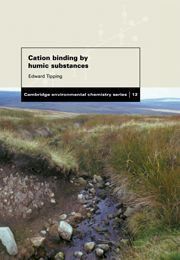Book contents
- Frontmatter
- Contents
- Preface
- 1 Introduction
- 2 Humic substances – a brief review
- 3 Environmental solution and surface chemistry
- 4 Proton dissociation from weak acids
- 5 Metal–ligand interactions
- 6 Methods for measuring cation binding by humic substances
- 7 Quantitative results with isolated humic substances
- 8 Cation binding sites in humic substances
- 9 Parameterised models of cation–humic interactions
- 10 Applications of comprehensive parameterised models
- 11 Predictive modelling
- 12 Cation–humic binding and other physico-chemical processes
- 13 Cation binding by humic substances in natural waters
- 14 Cation binding by humic substances in soils and sediments
- 15 Research needs
- References
- Index
3 - Environmental solution and surface chemistry
Published online by Cambridge University Press: 18 August 2009
- Frontmatter
- Contents
- Preface
- 1 Introduction
- 2 Humic substances – a brief review
- 3 Environmental solution and surface chemistry
- 4 Proton dissociation from weak acids
- 5 Metal–ligand interactions
- 6 Methods for measuring cation binding by humic substances
- 7 Quantitative results with isolated humic substances
- 8 Cation binding sites in humic substances
- 9 Parameterised models of cation–humic interactions
- 10 Applications of comprehensive parameterised models
- 11 Predictive modelling
- 12 Cation–humic binding and other physico-chemical processes
- 13 Cation binding by humic substances in natural waters
- 14 Cation binding by humic substances in soils and sediments
- 15 Research needs
- References
- Index
Summary
This chapter reviews briefly a number of basic topics in the field of physical, colloid and surface chemistry. The aim is to prepare the ground for consideration of cation–humic interactions per se, and to show their place in the chemistry of the aqueous natural environment (surface and groundwaters, soils and sediments). Fuller general accounts of the concepts and phenomena covered may be found in chemistry textbooks, and in texts on colloid and surface chemistry (e.g. Hiemenz, 1977; Shaw, 1978), and environmental chemistry, soil chemistry and aqueous geo-chemistry (e.g. Sposito, 1989; Morel & Hering, 1993; Schwarzenbach et al., 1993; Brezonik, 1994; Stumm & Morgan, 1996; Harrison & De Mora, 1996; Langmuir, 1997).
Solutions and solutes
A solution is a homogeneous mixture of two or more substances. Usually the most abundant is called the solvent, while the others are solutes. The solubility of a substance is its dissolved concentration at saturation, i.e. when the solution is in equilibrium with undissolved material, at a given temperature and pressure. Solutions may involve all kinds of substances, and may be formed by mixtures of liquids, solids and gases, but we are exclusively concerned with aqueous solutions.
Factors governing aqueous solubility
The solubility of a compound in water depends upon the polarities of its chemical groupings, and whether it can ionise. Common examples of polar groups are—OH, —NH2 and > C=O, which confer solubility by the formation of hydrogen bonds with water molecules.
- Type
- Chapter
- Information
- Cation Binding by Humic Substances , pp. 32 - 51Publisher: Cambridge University PressPrint publication year: 2002



